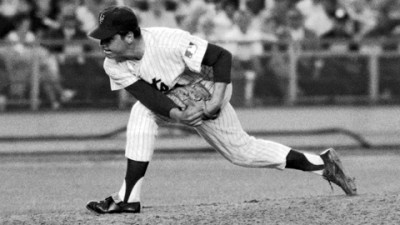He’s not part of the cadre of power pitching arms that have worked their way through the Met farm system and captivated the hopes and passions of Met fans everywhere. In fact, over the course of his professional baseball career, Paul Sewald has pretty much flown under the radar. It’s quite possible some Met fans might not have ever heard his name. But, pitching for Wally Backman this season in Las Vegas, Seward is doing what Seward always does – throwing strikes and retiring batters.
Paul Sewald is pitching in his home town of Las Vegas, part of a baseball class from the “Entertainment Capital of the World” that includes Bryce Harper, Kris Bryant and Joey Gallo. Unlike the big three who have built their reputations slamming baseballs long and far, Seward is quietly shaping his resume using pinpoint accuracy and precise placement of his pitches from the mound. And, if Sewald’s start this spring for the 51’s is an indicator, the home grown pitcher is likely to become a favorite option out of the pen this summer for Backman.
Yes, Sewald’s numbers are a tiny sample size, but they mirror the kind of work he has turned in at every level of the Mets farm season. In five appearances in the young season covering 6.1 innings, Seward has allowed six hits and two earned runs while striking out eight and walking only one. That’s good enough for a 2.84 ERA and 1.11 WHIP in the hitters haven that is the Pacific Coast League.
Sewald’s early work at the AAA level for the 51’s almost mirrors his accomplishments out of the pen last year in AA at Binghamton. Sewald became the B-Met closer early in the 2015 season when Chasen Bradford was elevated to Las Vegas. The 6’3” 210 pound righty was more than up to the task saving 24 games for Pedro Lopez in 25 opportunities while working in 44 games and throwing 50.1 innings with a 1.75 ERA and a 0.86 WHIP. Sewald struck out 56 batters as a B-Met while walking only 10.
At every level through the Met minor league system Sewald has distinguished himself by using pinpoint pitching control. In an interview with me last summer, Sewald was emphatic that throwing strikes is the most important part of pitching. “If you walk a batter, you have a zero percent chance of getting them out. You’ve handed a hitter a free opportunity to get on base,” Sewald replied with passion.
“If you watch batting practice, they throw the ball right down the middle at 72 miles per hour every single time, and the batter knows what’s coming, and they know where it is coming, and they still hit the ball for outs. So, why wouldn’t I throw the ball in the strike zone and make a hitter prove that he can get a hit. The best hitters in baseball make outs 7 out of 10 times. Those are pretty good odds. If I’m on the mound I want to make them prove they can get a hit. I don’t know if you’ve stood in the batter’s box and tried to hit a 90 mph fastball. It’s not easy, so why wouldn’t I try to throw the ball over the plate and get outs?”
Sewald talked about the importance of control, command of the strike zone and location to pitching success. He gets a little more specific when passing along advice for youngsters learning how to pitch.
“Obviously there is a little bit of difference if you throw the ball down the middle or throw it to the corners of the plate. But, if you first learn to throw it down the middle you can begin to expand a little bit and start to throw quality pitches. But, for me, it’s simply throw strikes and make a hitter prove that they can hit me. For the most part, guys don’t hit a lot of doubles and home runs very often, so if you don’t walk anyone, it takes 3 singles in an inning to bring in a run.”
In the radio interview we discussed the fact that two pitching styles dominate the mechanics pitchers use on the hill, the more old fashioned ‘drop and drive’ style of yesteryear and the more prevalent ‘tall and fall’ style of the modern age. I told Sewald that I had watched him pitch many times in Binghamton and his style appears solidly in the ‘drop and drive’ camp. In fact, I told him his delivery made me think of Tom Seaver every time I saw him pitch, staying low and thrusting his body forward toward the plate from that low position.
Sewald had never seen film of Seaver pitch. But, when someone from college who had watched him told him that his pitching style reminded him of Seaver, he decided to find some film and check it out.
“Don’t get me wrong, I don’t throw 97 miles per hour like Seaver. But, watching the film of Seaver I can understand how people might think my delivery is like the drop and drive style that a lot of guys from that era used. I use it to my advantage. It’s very deceptive. I step across my body, and have a low three-quarter arm angle. It can be very difficult for hitters to pick up the ball. I don’t throw 94-95 mph. I throw in the low 90’s. I have to throw the ball at the knees and in and out to the edges of the plate.”
Throughout his minor league career with the Mets, Sewald has been used as both a set-up guy and a closer. In the interview I wondered if Seward saw those roles differently. “I try not to view them as different. Throughout my professional career I have pitched anything from the 6th to the 9th and I try to treat each situation in a similar way. The most important thing is to make sure no runs get on the board. If it’s the ninth inning and i’m pitching for a save or its the sixth inning and I’m pitching for a single out, my focus is getting the next guy out.”
“As a relief pitcher your job is to come in, throw strikes, get quick outs and make sure no runs cross. So, I try not to think about if it’s a closer’s spot versus the set-up guy. I try to make the best pitch I can to every single hitter and try to get quick outs so I’m ready to go the next day, if they need me. For me, no matter what the situation, it’s about making the best pitch, getting the quick out, and if that’s at the end of the game when I’m done, then that’s the end of the game.”
Sewald throws a low 90’s fastball. His ‘go to’ pitch is a nasty slider that he can make look like a curve and even a cutter. The slider has proven effective against batters from both sides of the plate.
The story has been the same for Paul Sewald at what ever level he’s pitched. Challenge the hitter, move the ball in and out, keep the ball low, and throw strikes. The rest will take care of itself. That’s a Paul Seward recipe for pitching success.




I have become uncomfortable with the emphasis baseball has placed on pitch mph. It wasn’t always that way. Yes, it is sexy but ultimately it is getting batters out that quantifies a pitcher’s success. Pitch movement and control have as much to do with a pitcher’s ability.